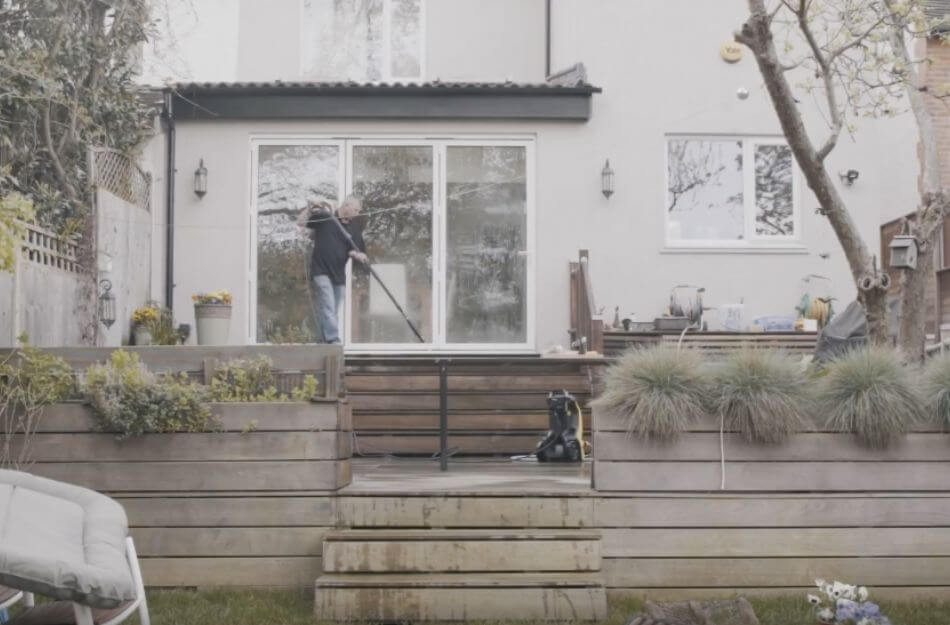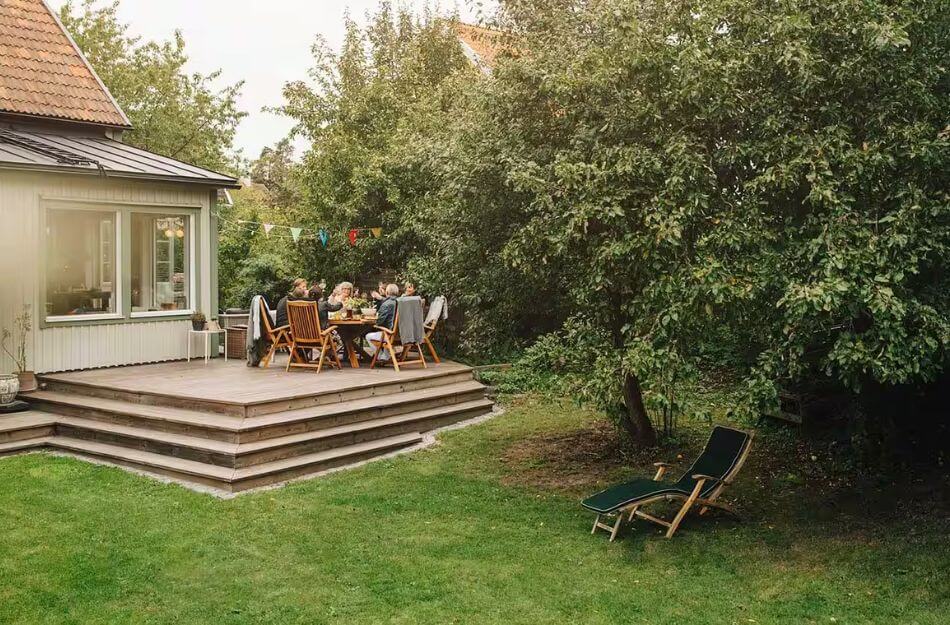Building a deck in winter is an interesting task to take on. However, you must decide the best material for such a purpose if you want your deck to withstand harsh weather and make it durable and sturdy.
The best decking material for winter is high-quality hardwood or composite wood. Although there are other options, you should install hardwood or composite decking for the most reliable solution.

Table of Contents
Popular Decking Materials
There are various decking materials in the market, such as softwood, hardwood, PVC, and concrete, but not all are budget-friendly or suitable for winter.
Besides, it is optional that every decking material is suitable according to the space you have available at hand and the type of deck you want to build.
Concrete
Concrete is your best option if you want strength and resistance against the weather. However, building an entire concrete deck is extremely hard and way too expensive.
As it is not a one-person job, you would need to hire professional servicemen for this. Hence, it becomes extremely costly as the construction material comes at high prices.
Talking about the advantages, a concrete deck is impenetrable by moisture, snowfall, and rain. It doesn’t succumb to weather conditions and can withstand enormous amounts of weight.
Moreover, you also do not require any sealing or staining for concrete.
However, provided the high cost of construction and the extremely difficult task, you can’t build a concrete deck at a greater height, and it has to be kept close to the ground.
PVC
PVC decks are a great idea for decking material for winter as they are not as expensive as concrete and are comparatively easy to build. However, your deck needs more quality and strength to withstand winters.
PVC decks are hard to repair if anything goes bad, and their maintenance cost is also quite high. Moreover, they need to exhibit good tensile strength, which makes them not the most recommended option.
Wood Types
Wood is the best solution you can have if you are looking for strength, resilience, reliability, and affordability all under one title.

Various types of woods come at various costs which provide you different levels of strength, and protection from factors such as; moisture, dryness, heat, weight, scratches, etc.
There are several wood types that you can choose from. Select your wood type smartly, as it can affect your overall and future maintenance costs.
But whatever you choose, make sure you treat it right and it will surely last you a long time before any maintenance or replacement is required.
See Also: Deck Landscaping Ideas With Rocks: Creative Outdoor Space
Natural Softwood
Softwood is a good idea if you want something cheaper than concrete but better resistant and stronger than PVC. However, it still does not have enough strength and resistance against moisture, weather conditions, or infestation.
If you want softwood to last longer, you must take care of sealing/staining and timely maintenance to ensure it doesn’t become subject to harsh winter.
Pine
Pine is relatively cost-effective, and if preserved correctly, it can be worth your buck.
Although it does not have a lot of strength and resistance against the weather, if you seal it correctly and it is timely maintained, it will surely last you a while.
Cedar
If your budget is slightly higher than pinewood, try cedar.
This is more expensive than pine but offers greater resistance against moisture and is more durable. It is strong and sturdy and will last a very long time once you seal it correctly.
Redwood
If you want the best choice in softwood, rosewood will surely be your forte. Coming in at the highest rates, redwood offers the greatest softwood strength and the most durability. Care for it well, and it will last you ages.
Natural Hardwood
Natural hardwood is one of the best options you have for winter-suitable decking materials. Depending on which hardwood you choose, it can be quite reasonable and give value to your money.
Hardwood is more robust and exhibits greater strength. Besides, if you use it with stainers or sealant, you will have a sturdy deck in no time.
However, as hardwood trees are slow-growing, they are less abundant than softwoods and are quite expensive.
Don’t Miss: How Long Should You Wait Before Painting A New Deck?
Oak
If you want to move into the preferred realm of hardwood, your starting point should be no other than oak.
This is the most affordable hardwood option and provides decent robustness and moisture resistance, making it a suitable decking material for winter.
Teak
Coming in above oak in the hardwood section, teak is famous for its insect and infestation-repellent qualities.
Besides, it is also very strong and doesn’t give in to moisture or dryness.
This is mainly because of the high oil quantity, making it super moisture-resistant. Although expensive, it provides appropriate value for your money and can withstand the harsh conditions of winter.
Ipe
This is the most popular among hardwoods and the most expensive. It is rare as South America is its sole native region and has already been over-harvested.
However, it provides extreme resistance against moisture, weather conditions, and scratches and is the most suitable hardwood for your deck.
Composite Woods
Composite woods are the best option for finding suitable decking material for winter. They are treated through various chemical treatments and are a mixture of wood, plastic, PVC, and other materials.

They exhibit greater resistance against strong weather conditions and are more robust than normal wood types. However, as functional as they are, they are also very costly.
Composite wood is not natural and is made for various purposes, such as strength and anti-decaying properties, mainly because it contains other composite materials, such as plastic and PVC.
Although it is the most expensive, it is also the most durable and reliable wood you can have for your deck.
The maintenance cost of composite wood is extremely low, which makes it a suitable option for long-term use.
Pressure Treated Lumber
This type of wood is treated with pressure to make it robust and resistant to the actions of wind and rain.
It offers optimal durability and resistance against moisture and weather conditions and can hold decent weights. This makes it a suitable choice for your decks in winter.
Green Lumber
If you want a robust decking material prone to infestations, green lumber is your go-to choice.
Green lumber is a specially treated wood that is highly effective against pest attacks, rotting, and similar issues normal wood faces. However, it is separate from green wood, a term used for freshly cut wood.
Although it is very cheap, it is still reasonably strong according to the price. You can’t use it as it is, and it is a must to get it sealed.
However, if you’ve taken good care of it, it can prove to be quite resilient and suitable against extreme weather conditions.
Kiln-dried Lumber
If it is already winter and you want to start your project but take your time before sealing/staining, KDAT is your best choice.
This is the most common type of lumber available in stores because it is pre-dried to a certain extent.
This allows more resistance against moisture; besides, kiln-dried lumber is very strong and doesn’t come very costly. Hence, making it a fast and suitable option for your deck-building requirements in winter.
Kiln-dried lumber will have a sign of KDAT ( Kiln Dried After Treatment) on the wood to indicate that it has been dried to some extent.
Composite Wood & Hardwood In Winters | A Good or Bad Idea?
Both composite and hardwoods are the most appropriate selection for decking material in winter. They are far tougher than most other materials and require much less maintenance.

They withstand harsh winters, rain, and snow and can also endure severe humidity and dryness. Besides, they also come on budget, so you don’t have to worry about breaking the bank.
Composite decking varies from your regular hardwood or softwood decking. It is a composite material made from hardwood and other synthetic items, making it far more efficient than regular wood. Hence, it is suitable for winter; you need not worry about rotting or decay.
On the other hand, the best feature of hardwood is its non-splitting nature which solves a hundred problems at once.
You can easily install any of these decking materials in winter as their properties allow them to withstand rough handling, snowfalls, and much more while enabling sturdiness and longevity.
Moreover, they require far less maintenance than many other types of decking materials, making them budget-friendly even in the long run.
In addition, composite decking eliminates the requirement of sanding down boards to make them smooth. Their texture is already smooth enough, making it easier to install and the process much quicker.
Although you would need to level the ground to provide a stable base for the platform, you do not need to cover the ground with weed control cloths as the weed plants do not affect composite decking.
In addition, there wouldn’t be any need to install risers to lift the platform above to protect it from the ground. However, if you want added height, then it is your choice.
Related: How To Build A Deck Without Digging Holes? Full Guide
How Should I Protect The Wood?
The best way to protect the wood for your deck is to get it sealed or stained. Many people argue about the functionality of wood when it comes to deck building.

For instance, concrete does not require much maintenance, and the same is the case with pvc.
However, wood is an all-rounder as discussed earlier. Whether you use hardwood or composite wood it is best that you get a protective layer on the top.
The purpose of thai layer is to prevent moisture from seeping into the pores and disturbing the structure from the inside.
Besides, if you have composite wood, the chemicals inside the wood fibers can get diluted if water reaches them. This might lower the functionality and efficiency of the chemicals which can in turn lead to vulnerabilities in the wood.
There are a few ways you can protect your wood:
- Sealants: Wood sealants are an excellent way to protect your decking material in winters. They are clear in color, and effective against the UV rays, and moisture; hence they preserve the condition of your wood for a long time. You can get a sealant for various prices depending upon the quality and how long it is going to last.
- Stains: Wood stains are yet another option you can consider to protect the surface of your wood. They are usually colored and add texture and shine to the surface of your deck. They come secondary to sealants as they are a bit cheap but don’t last very long. However, the longevity also depends on your use and the type of stain you’ve used. You can get oil-based, water-based, and hybrid stains to provide the most optimum protection to your deck, all season long.
- Paint: Wood paints also protect the surface of your deck from moisture, and other weather conditions. They can be colored and provide protection as good as the sealants. However, their only downside is the fact that they do not last long. You would have to get the deck recoated very often which makes the task expensive, as well as difficult.
Takeaway
All of the features mentioned earlier make hardwood and composite wood the best-suited winter decking materials.
Hence, installing decking in winter with these materials is easy and favorable due to their supreme quality and bucket-load of features.
Recent Posts
Although deck sealing may not be at the top of your summer to-do list, you shouldn’t put off a task.One such deck that channels the opposite of the lively and enjoyable vibe you want from an...
Any home would benefit from having a deck because it adds more area for socializing, relaxing, and outside activities.Garden decking that has been properly polished can be elegant and lovely. It...
